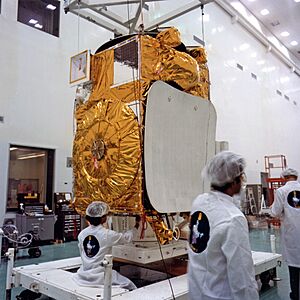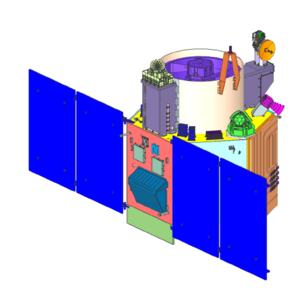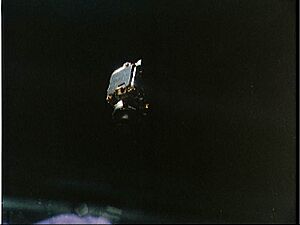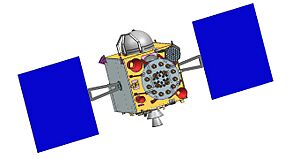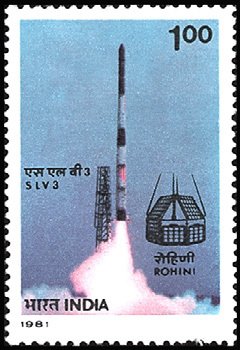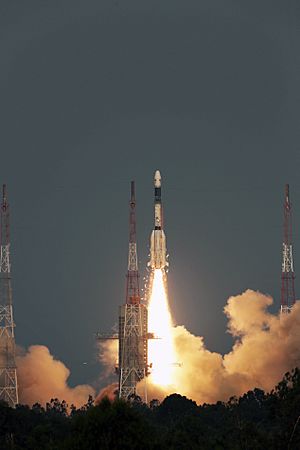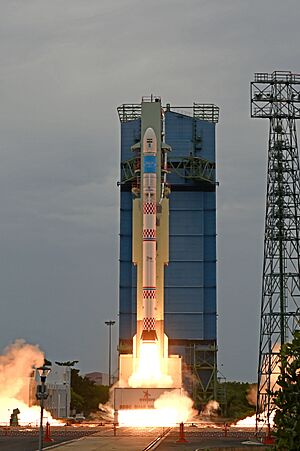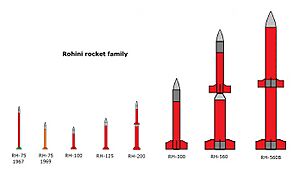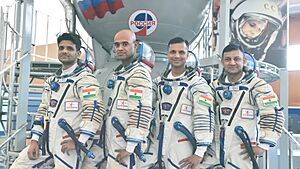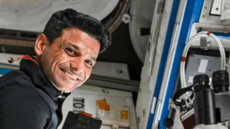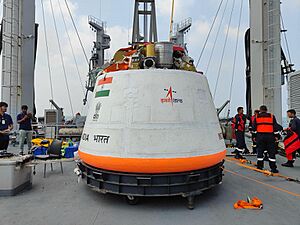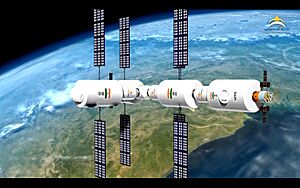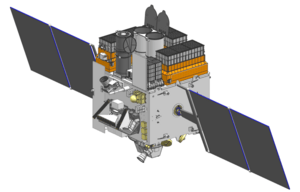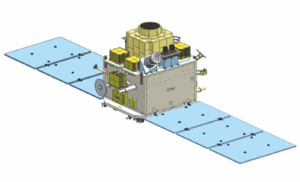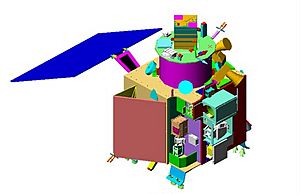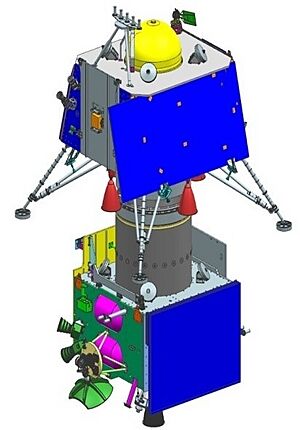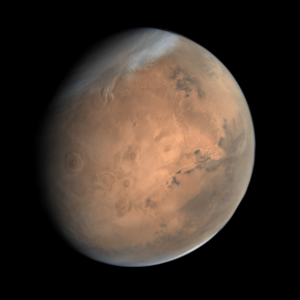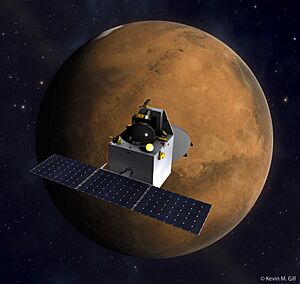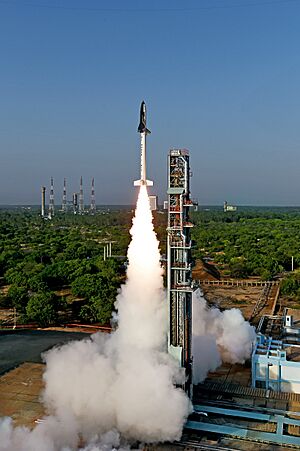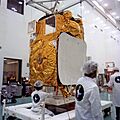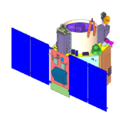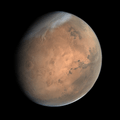ISRO facts for kids
| Bhāratīya Antarikṣa Anusandhāna Saṅgaṭhana | |
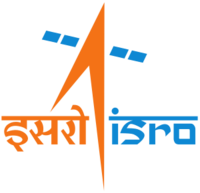 |
|
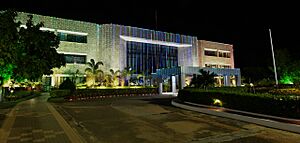
ISRO Headquarters at Bengaluru
|
|
| Agency overview | |
|---|---|
| Abbreviation | ISRO |
| Formed | 15 August 1969 |
| Preceding agency |
|
| Type | Government space agency |
| Jurisdiction | Department of Space |
| Headquarters | Bengaluru, Karnataka, India 13°2′7″N 77°34′16″E / 13.03528°N 77.57111°E |
| Motto | "Space technology in the service of humankind" |
|
Chairman
|
V. Narayanan |
| Primary spaceports |
|
| Owner | Government of India |
| Employees | 19,247 (as on 1 March 2022) |
| Annual budget | |
The Indian Space Research Organisation (ISRO) is India's national space agency. Its main office is in Bengaluru, Karnataka. ISRO is the main group for research and development in space for the Department of Space (DoS). The Prime Minister of India oversees the DoS. The head of ISRO is also the chief executive of the DoS.
ISRO's main jobs include space operations, space exploration, working with other countries in space, and creating new space technologies. It manages many satellites for taking pictures of Earth, sending messages, and remote sensing (gathering information from a distance). It also runs the GAGAN and IRNSS satellite navigation systems. ISRO has sent three missions to the Moon and one mission to Mars.
Before it was ISRO, it was called the Indian National Committee for Space Research (INCOSPAR). It was started in 1962 by the Government of India. This happened because scientist Vikram Sarabhai suggested it. INCOSPAR became ISRO in 1969. In 1972, the government created the Space Commission and the DoS. ISRO then became part of the DoS. This made space research in India official and organized.
ISRO built India's first satellite, Aryabhata. It was launched by the Soviet space agency Interkosmos in 1975. In 1980, ISRO launched the satellite RS-1. It used a rocket built in India called SLV-3. This made India the seventh country to launch satellites into orbit. Since then, ISRO has made different types of rockets. These rockets can launch many satellites and deep space missions. ISRO is one of only six government space agencies in the world. It can launch rockets fully on its own. It can also use cryogenic engines and send missions to other planets. It is also one of only four government space agencies that has successfully landed unmanned spacecraft softly on another body.
ISRO's work has greatly helped India's growth. It supports both civilian and military areas. This includes managing disasters, remote healthcare, navigation, and looking for information. Technologies developed by ISRO have also led to new inventions in engineering and other fields.
Contents
- History of India's Space Journey
- What ISRO Aims to Do
- How ISRO is Organized
- Satellite Programs
- Rockets and Launch Vehicles
- Human Spaceflight Program
- Space Science and Astronomy
- Exploring Beyond Earth
- Future Plans
- How ISRO's Work is Used
- Working with Other Countries
- Quick Facts
- Heads of ISRO
- Images for kids
- See also
History of India's Space Journey
Early Steps in Space
Modern space research in India began in the 1920s. Scientist S. K. Mitra studied the ionosphere using radio waves from the ground. Later, Indian scientists like C. V. Raman and Meghnad Saha also helped with space science ideas. After 1945, two important scientists, Vikram Sarabhai and Homi J. Bhabha, pushed space research forward. They studied cosmic radiation and the upper atmosphere.
In 1950, the Department of Atomic Energy (DAE) was created. It gave money for space research across India. In 1957, the Soviet Union launched Sputnik 1. This showed the world that space launches were possible.
In 1962, Prime Minister Jawaharlal Nehru set up INCOSPAR. This was based on Dr. Vikram Sarabhai's idea. At first, space activities were part of the DAE. Indian officers helped build rockets using their knowledge of fuels and light materials. H. G. S. Murthy became the first director of the Thumba Equatorial Rocket Launching Station. Here, sounding rockets were launched to study the upper atmosphere. India then developed its own sounding rockets called Rohini. These started launching in 1967.
Growing in the 1970s and 1980s
Under Prime Minister Indira Gandhi, INCOSPAR became ISRO. In 1972, a Space Commission and the Department of Space (DoS) were set up. ISRO then became part of the DoS. This made India's space program what it is today. India joined the Soviet Interkosmos program. This allowed India's first satellite, Aryabhata, to be launched by a Soviet rocket.
ISRO then worked on building its own rockets to put satellites into orbit. The goal was a rocket that could put a 35 kg (77 lb) object into low Earth orbit. It took 7 years to develop the Satellite Launch Vehicle (SLV-3). This rocket could put 40 kg (88 lb) into a 400-kilometre (250 mi) orbit. The first SLV-3 launch in 1979 did not work perfectly. But a successful launch followed in 1980. This carried a Rohini Series-I satellite. India became the seventh country to reach Earth's orbit. The Liquid Propulsion Systems Centre (LPSC) was set up in 1985. It started working on a stronger engine called Vikas.
At the same time, ISRO developed the Augmented Satellite Launch Vehicle (ASLV). This rocket was designed to launch satellites into geostationary orbit (GTO). The ASLV had some problems and was later stopped. ISRO also developed satellites for the Indian National Satellite System (INSAT) for communication. It also created the Indian Remote Sensing Programme (IRS) for Earth observation. These satellite systems grew to be some of the largest in the world.
The 1990s and Beyond
The Polar Satellite Launch Vehicle (PSLV) arrived in the 1990s. This was a big step for India's space program. Except for its first flight in 1994 and two partial failures, the PSLV has had over 50 successful flights. It has launched all of India's low Earth orbit satellites. It also launched small payloads to GTO and hundreds of satellites for other countries.
While PSLV was being used, a new rocket, the Geosynchronous Satellite Launch Vehicle (GSLV), was being developed. India tried to get special cryogenic engines from Russia. But the US stopped this. So, India started developing its own cryogenic technology in 1994. This took two decades to complete. India also developed its own satellite navigation system, IRNSS (now called NaVIC). This happened after the United States did not help India with Global Positioning System (GPS) technology during the Kargil war.
21st Century Achievements
In 2003, Prime Minister Atal Bihari Vajpayee asked scientists to work on landing humans on the Moon. ISRO launched Chandrayaan-1 in 2008. This mission was the first to confirm water on the Moon.
ISRO launched the Mars Orbiter Mission (Mangalyaan) in 2013. It became the first Asian spacecraft to reach Mars orbit. India was also the first country to succeed on its first try.
The GSLV rocket's cryogenic upper stage became ready. This made India the sixth country with full launch capabilities. A new, heavier rocket, LVM3, was introduced in 2014. It carries heavier satellites and will be used for future human space missions.
On August 23, 2023, India made its first soft landing on another celestial body. ISRO's Chandrayaan-3 became the first nation to land a spacecraft near the lunar south pole. It was also the fourth nation to successfully land a spacecraft on the Moon. The Vikram lander touched down at 6:04 pm IST.
India then successfully launched its first solar probe, the Aditya-L1. It lifted off on September 2, 2023.
On December 30, 2024, ISRO successfully launched the SpaDeX mission. This mission was a first for spacecraft rendezvous, docking, and undocking. It used two small satellites. On January 16, 2025, the ISRO Telemetry, Tracking and Command Network confirmed the docking was successful. India became the fourth country to achieve successful space docking. ISRO also managed to control two satellites as one after docking.
ISRO's Logo
ISRO has had an official logo since 2002. It shows an orange arrow pointing up. This arrow is connected to two blue satellite panels. The name ISRO is written next to it. It is in orange Devanagari script on the left and blue English text on the right.
What ISRO Aims to Do

As India's national space agency, ISRO's goal is to use space for many things. This includes research, looking for information, and communication. It designs and builds space rockets and satellites. It also explores the upper atmosphere and deep space. ISRO has also helped new private space companies grow in India.
Vikram Sarabhai, the first head of INCOSPAR, spoke about why a space program was important for India in 1969. He said India did not want to compete with rich countries in exploring the Moon or planets. But he believed India must be excellent in using advanced technologies. This was to solve real problems for people and society in India.
A. P. J. Abdul Kalam, a former president of India, also spoke about this. He said some people wondered why India needed space activities. This was because India was struggling to feed its people. But Prime Minister Nehru and Prof. Sarabhai had a clear vision. They wanted Indians to be leaders in using advanced technologies. This was to solve their real-life problems, not just to show off.
India's economic growth has made its space program more active. The country wants to be more self-reliant in space technology. In 2008, India launched 11 satellites. Nine of these were from other countries. ISRO became the first nation to launch 10 satellites on one rocket. ISRO uses two main satellite systems. The Indian National Satellite System (INSAT) is for communication. The Indian Remote Sensing Programme (IRS) satellites are for managing natural resources.
How ISRO is Organized
ISRO is managed by the Department of Space (DoS). The Space Commission oversees the DoS. The DoS also manages other agencies and institutes:
- Indian Space Research Organisation (ISRO)
- Antrix Corporation – ISRO's marketing branch in Bengaluru
- Physical Research Laboratory (PRL), Ahmedabad
- National Atmospheric Research Laboratory (NARL), Gadanki, Andhra Pradesh
- NewSpace India Limited – Commercial branch in Bengaluru
- North-Eastern Space Applications Centre (NE-SAC), Umiam
- Indian Institute of Space Science and Technology (IIST), Thiruvananthapuram – India's space university
Research Centers
| Center | Location | What it Does |
|---|---|---|
| Vikram Sarabhai Space Centre | Thiruvananthapuram | This is ISRO's largest and main technical center. It develops rockets like the SLV-3, ASLV, and PSLV. It also supports rocket launches and the Rohini Sounding Rocket program. It is also developing the GSLV rockets. |
| Liquid Propulsion Systems Centre | Thiruvananthapuram and Bengaluru | This center designs, develops, and tests liquid fuel engines for rockets and satellites. Most of the testing happens at IPRC in Mahendragiri. |
| Physical Research Laboratory | Ahmedabad | This institute studies solar and planetary physics, infrared astronomy, and other space sciences. It also runs an observatory in Udaipur. |
| National Atmospheric Research Laboratory | Tirupati | NARL does basic and applied research in atmospheric and space sciences. |
| Space Applications Centre | Ahmedabad | SAC focuses on how to use space technology in real life. It researches things like satellite communications, remote sensing, and weather monitoring. |
| North-Eastern Space Applications Centre | Shillong | This center helps develop the North East region. It uses remote sensing, GIS, and satellite communication for projects. |
Test Centers
| Center | Location | What it Does |
|---|---|---|
| ISRO Propulsion Complex | Mahendragiri | This center tests and puts together liquid fuel engines and parts for rockets and satellites. |
Rocket Building and Launch Sites
| Center | Location | What it Does |
|---|---|---|
| U. R. Rao Satellite Centre | Bengaluru | This is one of ISRO's main satellite technology centers. It builds Indian spacecraft. Satellites like Aaryabhata and IRS-1A were built here. |
| Laboratory for Electro-Optics Systems | Bengaluru | This ISRO unit develops sensors that help satellites know their position. It also makes high-precision optics for cameras on all ISRO satellites. |
| Satish Dhawan Space Centre | Sriharikota | This island facility is where India launches its satellites and sounding rockets. It also has India's largest Solid Propellant Space Booster Plant (SPROB). |
| SSLV Launch Complex | Kulasekarapattinam | This site is being built. It will be used for smaller rockets like the SSLV and rockets from private companies. |
| Thumba Equatorial Rocket Launching Station | Thiruvananthapuram | TERLS is used to launch sounding rockets. |
Tracking and Control Centers
| Center | Location | What it Does |
|---|---|---|
| Indian Deep Space Network (IDSN) | Bengaluru | This network receives and stores data from spacecraft. It can track satellites very far away, even beyond the Moon. |
| National Remote Sensing Centre | Hyderabad | NRSC uses remote sensing to manage natural resources and study aerial surveys. It also has training facilities in Dehradun. |
| ISRO Telemetry, Tracking and Command Network | Bengaluru (headquarters) and worldwide | This center develops software and handles ground operations. It tracks, sends commands to, and supports satellites. |
| Master Control Facility | Bhopal; Hassan | This facility helps move geostationary satellites into their correct orbits. It also tests and operates them once they are in space. |
| Space Situational Awareness Control Centre | Peenya, Bengaluru | This center uses telescopes and radars to watch for space debris. It helps protect India's satellites. It also reduces ISRO's need to rely on NORAD for this information. |
Training and Development
| Center | Location | What it Does |
|---|---|---|
| Indian Institute of Remote Sensing (IIRS) | Dehradun | IIRS trains professionals in remote sensing, geoinformatics, and GPS technology. This is for managing natural resources and disasters. |
| Indian Institute of Space Science and Technology (IIST) | Thiruvananthapuram | This institute offers degrees in Aerospace Engineering and Electronics. Its students often join ISRO centers. |
| Development and Educational Communication Unit (DECU) | Ahmedabad | This center focuses on education, research, and training. It works closely with the INSAT program. |
Commercial Branches
- Antrix Corporation: This is ISRO's marketing branch. It promotes products, services, and technology developed by ISRO.
- NewSpace India Limited: This branch markets spin-off technologies and helps industries get involved in space programs.
Space Technology Incubation Centers (S-TICs)
ISRO has opened S-TICs at top technical universities in India. These centers help new companies (startups) create space-related products. They bring together industry, universities, and ISRO for research and development.
Advanced Space Research Group (ASRG)
ISRO and the Indian Institute of Space Science and Technology (IIST) work together. The ASRG at IIST has full access to ISRO facilities. This helps IIST become a leading space research institute. It can help ISRO with future space exploration missions.
Directorate of Space Situational Awareness and Management (DSSAM)
To rely less on North American Aerospace Defense Command (NORAD), ISRO is setting up telescopes and radars. These are in four locations to watch for space debris. This helps protect India's satellites. The DSSAM in Bengaluru collects data on inactive satellites. It also researches how to remove space debris.
ISRO started a project called Network for Space Object Tracking and Analysis (NETRA). This system helps India track objects in space. It can also detect intercontinental ballistic missiles and other space attacks. All radars and telescopes are connected through NETRA.
India signed an agreement with the US in April 2022. This allows them to share space information. It helps protect satellites from natural and human-made threats. On July 11, 2022, ISRO opened the ISRO System for Safe and Sustainable Space Operations Management (IS4OM) center in Peenya. This center provides information on satellite collisions, re-entry risks, and space weather.
IS4OM's Achievements
On March 7, 2023, IS4OM successfully guided the old satellite Megha-Tropiques back into Earth's atmosphere. It broke apart over the Pacific Ocean. This was done to follow international rules about reducing space debris.
S. Somanath, the head of ISRO, said that by 2030, all Indian space activities should be "debris-free." This means missions should not leave behind space junk.
Satellite Programs
Since Aryabhata launched in 1975, India has sent many satellites into space. ISRO now operates one of the largest groups of communication and Earth imaging satellites. These are used for both military and civilian purposes.
The IRS Satellites
The Indian Remote Sensing satellites (IRS) are India's Earth observation satellites. They are the largest group of remote sensing satellites for civilian use. They provide data for many national development programs. These satellites are mostly in polar orbits. They help with city planning, ocean studies, and environmental monitoring. They also help Indian agencies with optical, radar, and electronic information gathering.
The INSAT Satellites
The Indian National Satellite System (INSAT) is India's telecommunication system. It is a series of geostationary satellites built by ISRO. They help with telecommunications, broadcasting, weather forecasting, and search-and-rescue. INSAT has become the largest communication system in the Asia-Pacific Region. It is a joint effort by different government departments. The names of these satellites changed to "GSAT" and then to "CMS" from 2020. The Indian Armed Forces also use these satellites.
The Ministry of Civil Aviation decided to use an Indian Satellite-Based Regional GPS Augmentation System. This system is called GAGAN – GPS Aided GEO Augmented Navigation. It helps with civil aviation. The Airports Authority of India and ISRO worked together on this.
NavIC is India's own regional navigation satellite system. It provides accurate location information to users in India and up to 1,500 km (930 mi) from its borders. NavIC offers two types of services. It provides a position accuracy better than 20 m (66 ft) in its main service area.
Other Satellites
Kalpana-1 was ISRO's first satellite just for weather. The Indo-French satellite SARAL launched on February 25, 2013. SARAL helps monitor the ocean's surface and sea levels.
Rockets and Launch Vehicles
In the 1960s and 1970s, India started building its own rockets. This was due to global politics and money reasons. By the 1980s, India had developed the Satellite Launch Vehicle-3 and the more advanced Augmented Satellite Launch Vehicle (ASLV).
Satellite Launch Vehicle (SLV)
The SLV-3 was India's first space rocket. Its first launch in 1979 failed. But a successful launch in 1980 made India the sixth country able to launch satellites into orbit. After this, work began on bigger rockets.
Augmented Satellite Launch Vehicle (ASLV)
The ASLV was another small rocket from the 1980s. It was meant to develop technologies for putting satellites into geostationary orbit. ASLV had repeated failures and was later stopped.
Polar Satellite Launch Vehicle (PSLV)
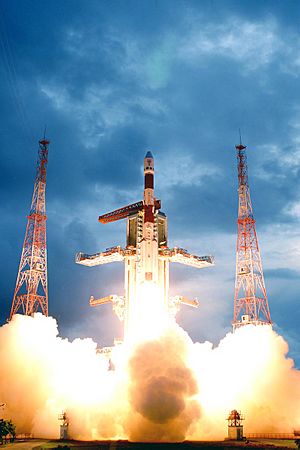
The PSLV is India's first medium-lift launch vehicle. It allowed India to launch all its remote-sensing satellites into Sun-synchronous orbit. The PSLV had one failure in its first launch in 1993. Besides two other partial failures, the PSLV has become ISRO's main workhorse. It has had over 50 launches, putting hundreds of Indian and foreign satellites into orbit.
Geosynchronous Satellite Launch Vehicle (GSLV)
The GSLV was planned in the 1990s to carry heavy payloads to geostationary orbit. ISRO faced challenges in building the GSLV. It took a decade to develop the CE-7.5 engine in India. This was because the US stopped India from getting cryogenic technology from Russia.
Launch Vehicle Mark-3 (LVM3)
The LVM3, earlier known as GSLV Mk III, is ISRO's heaviest rocket. It has a more powerful cryogenic engine and boosters than the GSLV. This means it can carry much heavier satellites. The LVM3 is expected to carry India's first crewed mission to space. It will also test the SCE-200 engine for future heavy rockets.
Small Satellite Launch Vehicle (SSLV)
The Small Satellite Launch Vehicle (SSLV) is a new rocket from ISRO. It can carry 500 kg (1,100 lb) to low Earth orbit or 300 kg (660 lb) to Sun-synchronous orbit. It is designed to launch small satellites and can drop off multiple satellites in different orbits.
Rohini Sounding Rockets
Rohini is a series of sounding rockets made by ISRO. They are used to study weather and the atmosphere. These rockets can carry payloads from 2 to 200 kilograms (4.4 to 440.9 lb) to altitudes between 100 to 500 kilometres (62 to 311 mi). ISRO currently uses several Rohini rockets. They are launched from Thumba Equatorial Rocket Launching Station (TERLS) and the Satish Dhawan Space Centre.
Human Spaceflight Program
ISRO first talked about sending humans into space in 2006. Work then began on the needed equipment and spacecraft. Tests for crewed missions started in 2007. The Space Capsule Recovery Experiment (SRE) was launched and returned safely after 12 days.
In 2018, Prime Minister Narendra Modi announced that India would send astronauts into space by 2022. This would use the new Gaganyaan spacecraft. ISRO has developed most of the needed technologies. These include the crew module, escape system, space food, and life support. The project will send two or three Indians to space. They will go to an altitude of 300–400 km (190–250 mi) for at least seven days. The GSLV Mk-III rocket will be used.
Astronaut Training
The new Human Space Flight Centre (HSFC) will manage India's human spaceflight program. ISRO will set up an astronaut training center in Bengaluru. It will prepare astronauts for flights. This includes training for rescue, recovery, and living in microgravity. It will also study space radiation. ISRO built centrifuges to prepare astronauts for the strong forces during launch. Existing launch facilities at Satish Dhawan Space Centre are being updated. Four Indian Air Force personnel finished training in Russia in March 2021.
Axiom Mission 4
Axiom Mission 4 (Ax‑4) launched in June 2025. Shubhanshu Shukla was the mission pilot. This was the first time an Indian astronaut traveled to the International Space Station (ISS). The mission was organized by Axiom Space and launched by SpaceX. Shukla conducted about 60 experiments on the ISS for two weeks. At least seven of these were developed by ISRO or Indian universities. These experiments covered topics like how screens affect the brain, how microbes adapt, muscle loss, and how crops grow in microgravity. ISRO Chairman V. Narayanan said Shukla's work will help India's Gaganyaan human spaceflight program.
Crewed Spacecraft
ISRO is working on a spacecraft that can stay in low Earth orbit for seven days. This spacecraft, called Gaganyaan, will be the base for the Indian Human Spaceflight Programme. It is being built to carry up to three people. A future version will be able to meet and connect with other spacecraft. The first crewed mission will use a spacecraft weighing about 3 tonnes (6,600 lb). It will be placed in low Earth orbit at about 400 kilometres (250 mi) altitude. It will support two crew members for up to seven days.
Space Station
India plans to build a modular space station after the Gaganyaan program. The proposed Bharatiya Antariksh Station would weigh about 20 tonnes (44,000 lb). It would be in low Earth orbit at about 400 kilometres (250 mi) altitude. It is meant to support up to three astronauts for missions lasting 15 to 20 days. ISRO aims to launch the station five to seven years after Gaganyaan is finished. The station is planned to grow in stages. It will be a place for international teamwork in research. This includes exploring other planets, studying microgravity, and space biology.
Space Science and Astronomy
ISRO and Tata Institute of Fundamental Research have used a balloon launch base in Hyderabad since 1967. This location is good for studying cosmic X-ray background.
ISRO helped find three types of bacteria in the upper atmosphere. These bacteria are very resistant to ultra-violet radiation. They are not found anywhere else on Earth. This makes people wonder if they came from space. One type was named Bacillus isronensis to honor ISRO.
Astrosat
Launched in 2015, Astrosat is India's first special space observatory that studies different wavelengths of light. It observes things like active galactic nuclei, hot white dwarfs, and supermassive black holes.
XPoSat
The X-ray Polarimeter Satellite (XPoSat) studies black holes and polarization. It launched on January 1, 2024. It is expected to work for at least five years.
Exploring Beyond Earth
Lunar Exploration
Chandryaan (meaning "Mooncraft") is India's series of missions to explore the Moon. The first mission included an orbiter and an impact probe. Later missions include landers, rovers, and sample return missions.
- Chandrayaan-1
Chandrayaan-1 was India's first mission to the Moon. It was a robotic mission with a lunar orbiter and an impactor called the Moon Impact Probe. ISRO launched it on October 22, 2008. It entered lunar orbit on November 8, 2008. It carried equipment to map the Moon's surface and its chemicals. The mission confirmed the presence of water on the Moon.
- Chandrayaan-2
Chandrayaan-2 was the second mission to the Moon. It included an orbiter, a lander, and a rover. It launched on July 22, 2019. The mission aimed to explore the lunar south pole region. The Vikram lander, carrying the Pragyan rover, was supposed to land on September 7, 2019. However, the lander crashed due to a software problem. The lunar orbiter worked well and continued to serve for seven years.
- Chandrayaan-3
Chandrayaan-3 was India's second attempt to soft-land on the Moon. It only included a lander and a rover. It communicated with the orbiter from the previous mission.
On August 23, 2023, ISRO became the first space agency to successfully land a spacecraft near the lunar south pole. ISRO is the fourth space agency ever to land on the Moon.
Mars Exploration
- Mars Orbiter Mission (MOM) or (Mangalyaan-1)
The Mars Orbiter Mission (MOM), also known as Mangalyaan (meaning "MarsCraft"), launched on November 5, 2013. It entered Mars orbit on September 24, 2014. India became the first country to reach Mars orbit on its first try. The mission cost a low $74 million. MOM carried five science instruments.
Mars and Moon Research Station
Researchers have found that Ladakh is the best place for India's first Mars and Moon research station. This station will be used for studying geology and life in space. It will also train astronauts and test space technologies.
In Ladakh, Aaka Space Studio and ISRO will lead a 21-day Mars and Moon simulation mission. This is a big step for India's human spaceflight program. It will copy the tough conditions of space. The mission will test human health and how long people can stay isolated. It will also test life support systems.
Solar Probes
- Aditya-L1
On September 2, 2023, ISRO launched the 400 kg (880 lb) Aditya-L1 mission. It studies the solar corona (the Sun's outer atmosphere). It is India's first space-based solar telescope. Its main goal is to study coronal mass ejections (CMEs). These are big bursts of solar material. On January 6, 2024, Aditya-L1 successfully entered its final orbit. It is around the first Sun-Earth Lagrangian point (L1), about 1.5 million kilometers from Earth.
Future Plans
ISRO is working on more powerful and cleaner rocket engines. This will help them build much heavier rockets. They also plan a space station above Earth where astronauts can stay for 15–20 days. This is planned for 5–7 years after Gaganyaan. They also want to develop electric and nuclear power for satellites. This will make satellites lighter and last longer. Long-term plans include sending humans to the Moon and other planets.
Engines and Rockets
Semi-cryogenic Engine
The SCE-200 is a new rocket engine that uses kerosene (called "ISROsene") and liquid oxygen (LOX). It will be cleaner and much more powerful than the current Vikas engine. When used with the LVM3, it will increase its payload capacity. It will also be used in groups to power India's heavy rockets in the future.
On March 28, 2025, ISRO announced good progress on this engine. It has a high thrust of 2,000 kN.
Methalox Engine
ISRO is developing reusable engines that use methane and LOX. Methane is cleaner and leaves no residue. This means the engine needs less repair. Tests for these engines began in 2020.
Modular Heavy Rockets
India's current rockets cannot launch very heavy satellites (over 4 tons) to geostationary orbit. The NGLV is planned to fix this. ISRO is studying heavy (HLV) and super heavy-lift launch vehicle (SHLV) rockets. They are designing modular rockets with parts that can be swapped. This will make them faster to build. ISRO officials have mentioned an HLV that can carry 10-tonne (9.8-long-ton; 11-short-ton) and an SHLV that can carry 50–100 tonnes (49–98 long tons; 55–110 short tons) into orbit.
The agency plans a rocket for the 2020s that can carry about 16 t (16-long-ton; 18-short-ton) to geostationary transfer orbit. This is four times what the LVM3 can carry. A family of five modular rockets called "Next Generation Launch Vehicle" (NGLV) is being planned. They will share parts and replace ISRO's current PSLV and GSLV rockets. These rockets will use LOX-Methane engines. They will be able to lift from 4.9 t (4.8-long-ton; 5.4-short-ton) to 16 t (16-long-ton; 18-short-ton) to geostationary transfer orbit.
Reusable Launch Vehicles
ISRO has two projects for reusable rockets. One is the ADMIRE test vehicle, which takes off and lands vertically. The other is the RLV-TD program. This program aims to build an autonomous spacecraft that launches vertically but lands like a plane.
To make a fully reusable rocket, ISRO is doing a series of technology tests. The winged Reusable Launch Vehicle Technology Demonstrator (RLV-TD) is used for this. The RLV-TD tests technologies like very fast flight and autonomous landing. The first test, the Hypersonic Flight Experiment (HEX), was completed in February 2016. A larger version could be a reusable booster for future rockets. HEX will be followed by landing and return flight experiments.
Spacecraft Power and Movement
- Electric Thrusters
India is working on replacing traditional chemical rocket engines with Hall-effect and plasma thrusters. These will make spacecraft lighter. GSAT-4 was the first Indian spacecraft to have electric thrusters, but it did not reach orbit. GSAT-9, launched in 2017, used xenon-based electric propulsion for its in-orbit tasks. GSAT-20 is expected to be India's first fully electric satellite.
On March 28, 2025, ISRO reported that its 300 mN xenon-based Stationary Plasma Thruster worked for 1,000 hours in a vacuum. This electric propulsion system will replace chemical systems in future satellites. It will help satellites move into orbit and stay there. This means satellites can carry more equipment because they are lighter.
- Alpha Source Thermoelectric Propulsion Technology
Radioisotope thermoelectric generator (RTG), also called alpha source thermoelectric technology by ISRO, is a type of atomic battery. It uses heat from radioactive material to power spacecraft. In January 2021, ISRO asked for designs for a 100-watt RTG. RTGs make spacecraft last much longer and are lighter than solar panels. Developing RTGs will allow ISRO to send long missions to the outer planets.
- Radioisotope Heater Unit
ISRO included two radioisotope heater units in the Chandrayaan-3 propulsion module for testing. They worked perfectly.
- Nuclear Propulsion
ISRO plans to work with the Department of Atomic Energy. They want to use nuclear propulsion technology for future space missions.
Quantum Technology
On January 27, 2022, the Space Applications Centre and Physical Research Laboratory showed how to send secure messages using quantum technology. This included video chatting.
- Satellite-based Quantum Communication
At the India Mobile Congress 2023, ISRO showed its satellite-based quantum communication technology. ISRO is creating ways to stop quantum computers from breaking current secure communications. In September 2023, ISRO showed free-space quantum communication over 300 meters. This included live video conferencing using quantum-encrypted signals.
Future Space Probes
| Destination | Craft name | Launch vehicle | Year |
|---|---|---|---|
| Moon | Chandrayaan-4 | 2 × LVM3 | 2027 |
| Moon | LUPEX | H3 | 2028-29 |
| Venus | Venus Orbiter Mission | LVM3 | March 29, 2028 |
| Mars | Mars Lander Mission | LVM3 | NET 2031 |
Lunar Exploration
- Chandrayaan-4
Chandrayaan-4 is a planned mission to bring Moon samples back to Earth. It is the fourth mission in the Chandrayaan programme. The planning is almost done. It is expected to launch around 2027. It plans to bring back up to 3 kilograms (6.6 lb) of lunar soil from near the Shiv Shakti point.
- Lunar Polar Exploration Mission (LUPEX)
LUPEX is a planned robotic mission by ISRO and Japan Aerospace Exploration Agency (JAXA). It will send a rover and lander to explore the Moon's south pole. JAXA will likely provide the rocket and rover. ISRO will be in charge of the lander.
- Crewed Lunar Landing
ISRO aims to put an astronaut on the Moon by 2040.
Mars Exploration
The next Mars mission, Mars Lander Mission or Mangalyaan 2, is planned for launch in 2031. This new mission will include a rover, a helicopter, a sky crane, and a supersonic parachute.
Venus Exploration
ISRO is planning an orbiter mission to Venus called Venus Orbiter Mission. It could launch as early as 2028. It will study Venus's atmosphere. The mission will include an instrument called Venus Infrared Atmospheric Gases Linker (VIRAL). This was developed with French and Russian space agencies.
The Venus Orbiter Mission (VOM) was approved on September 18, 2024. It will orbit Venus to understand its surface, atmosphere, and how the Sun affects it. This mission will help understand how Earth and Venus developed.
Asteroids and Outer Solar System
ISRO is also thinking about missions to asteroids and Jupiter. The best time to launch a mission to Jupiter is every 33 months. If a Jupiter mission launches, it would need to fly by Venus. Developing RTEG power could allow ISRO to send missions even deeper into space.
Space Telescopes and Observatories
AstroSat-2
AstroSat-2 is the next version of the AstroSat mission.
Exoworlds
Exoworlds is a joint idea by ISRO, IIST, and the University of Cambridge. It is a space telescope for studying the atmospheres of exoplanets. It is planned for 2025.
Indian Spectroscopic and Imaging Space Telescope (INSIST)
The Indian Spectroscopic and Imaging Space Telescope (INSIST) will take high-resolution images in ultraviolet and visible light. It will also do spectroscopy. ISRO has approved early funding for this project.
DAKSHA
DAKSHA is a proposed mission to study high-energy events in space. Its main goals are to study gravitational waves and gamma-ray bursts. It will use two satellites with three instruments each.
Proposed Space Weather Probe
ISRO is thinking about a mission to the stable L5 Lagrange point. This mission would study space weather.
Proposed LEO Solar Observatory
ISRO has proposed launching another solar probe. This one would be placed in Low-Earth Orbit.
Upcoming Satellites
| Satellite name | Launch vehicle | Year | Purpose | Notes |
|---|---|---|---|---|
| GISAT 2 | GSLV | TBA | Earth observation | Will provide continuous observation of India and help monitor natural hazards and disasters quickly. |
| IDRSS | GSLV | TBA | Data relay and satellite tracking constellation | Helps satellites in low Earth orbit communicate with ground stations all the time. |
| DISHA | PSLV | 2025 | Aeronomy | A constellation of two satellites to study the ionosphere at high altitudes. |
| AHySIS-2 | PSLV | TBA | Earth observation | A follow-up to the HySIS satellite for hyperspectral Earth imaging. |
| NISAR | GSLV | 2025 | Earth observation | A joint project with NASA to develop and launch a dual-frequency radar satellite for remote sensing. It will be the first radar imaging satellite with two bands. |
Geospatial Intelligence Satellites
ISRO plans to launch 50 artificial intelligence-based satellites between 2024 and 2028. These satellites will collect geospatial intelligence (GEOINT). They will track military movements and photograph important areas. They will use thermal, optical, and synthetic aperture radar (SAR) technologies. Each satellite will use AI to communicate and work with others in space.
New Launch Facility
- SSLV Launch Complex
The SSLV Launch Complex is a spaceport being built in Kulasekarapattinam, Thoothukudi district in Tamil Nadu. Once finished, it will be ISRO's second launch facility. It will mainly be used for launching the SSLV.
How ISRO's Work is Used
Telecommunication
India uses its satellite communication network for many things. This includes managing land and water, forecasting natural disasters, and weather forecasting. Businesses and government services also use satellite technology.
Military Uses
The Integrated Space Cell helps use India's space assets for military purposes. It also looks for threats to these assets. This group uses space technology, including satellites.
India has 14 satellites for military use. This includes GSAT-7A for the air force and GSAT-7 for the navy. GSAT-7A helps the air force link different radar stations and aircraft. GSAT-7 helps the navy monitor the Indian Ocean Region. The RISAT series of satellites are also for military use. ISRO launched EMISAT on April 1, 2019. EMISAT is an electronic intelligence satellite. It helps the Indian Armed Forces by finding and locating enemy radars.
India's satellites and rockets have also helped its military. The Agni missile was developed from the SLV-3 rocket. A.P.J. Abdul Kalam, who led the SLV-3 project, later led the missile program. He used ideas from SLV-3 to design the Agni missile.
Education
Universities like the Indira Gandhi National Open University use satellites for education. Between 1975 and 1976, India ran a large program using space technology. It reached 2,400 villages with educational video programs. This experiment, called Satellite Instructional Television Experiment (SITE), greatly improved rural education.
Telemedicine
ISRO has used its technology for telemedicine. This connects patients in rural areas to doctors in cities using satellites. Doctors in cities can diagnose and advise patients in remote areas through video conferencing. Mobile telemedicine vans also visit distant places to help patients.
Biodiversity Information System
ISRO helped create India's Biodiversity Information System. This system uses satellite remote sensing to map vegetation. It links information about plant species with their locations. This helps study important ecological areas.
Cartography (Map Making)
The Indian IRS-P5 (CARTOSAT-1) satellite had special equipment for making maps. IRS-P5 was followed by the more advanced IRS-P6, also used for agriculture. The CARTOSAT-2 project came after CARTOSAT-1. It could take specific images of areas.
Spin-offs (New Uses for Technology)
ISRO's research has led to many new technologies for other areas. Examples include bionic limbs for people with disabilities. Silica aerogel helps keep Indian soldiers warm in very cold places. Distress alert transmitters help in accidents. Doppler weather radar and various sensors are used in engineering industries.
Working with Other Countries
ISRO has signed many agreements with countries around the world. These include Afghanistan, Australia, Canada, France, Germany, Japan, Russia, the United States, and many others. They also work with international groups like the European Space Agency (ESA).
Important Joint Projects
- Chandrayaan-1 carried science instruments from NASA, the European Space Agency, and other countries.
- For the Gaganyaan mission, ISRO and ESA agreed to provide ground station support.
- Indo-French Satellite Missions
ISRO has two joint satellite missions with France's CNES. These are the retired Megha-Tropiques (to study the water cycle) and the active SARAL (for measuring heights). A third mission, TRISHNA, is being planned. It will be an Earth observation satellite.
- LUPEX
The Lunar Polar Exploration Mission (LUPEX) is a joint mission with Japan. India is responsible for the soft landing technology.
- NISAR
NASA-ISRO Synthetic Aperture Radar (NISAR) is a joint project with the US. It is a radar project that will use two frequencies. It will be the world's first radar imaging satellite to do so.
Other notable collaborations include:
- ISRO helps with the international COSPAS/SARSAT Programme for Search and Rescue.
- India has a United Nations-sponsored center for space science education in Asia and the Pacific.
- India is a member of many international space committees and organizations.
- India contributes to the planned BRICS virtual constellation for remote sensing.
Quick Facts
Last updated: March 26, 2023
- Total foreign satellites launched by ISRO: 417 (from 34 countries)
- Spacecraft missions: 116
- Rocket launches: 86
- Student satellites: 13
- Re-entry missions: 2
Heads of ISRO
List of Chairpersons (since 1963) of ISRO:
- Vikram Sarabhai (1963–1971)
- M. G. K. Menon (1972)
- Satish Dhawan (1973–1984)
- U. R. Rao (1984–1994)
- K. Kasturirangan (1994–2003)
- G. Madhavan Nair (2003–2009)
- K. Radhakrishnan (2009–2014)
- Shailesh Nayak (2015)
- A. S. Kiran Kumar (2015–2018)
- K. Sivan (2018–2022)
- S. Somanath (2022–2025)
- V. Narayanan (2025–present)
Images for kids
See also
 In Spanish: Agencia India de Investigación Espacial para niños
In Spanish: Agencia India de Investigación Espacial para niños



